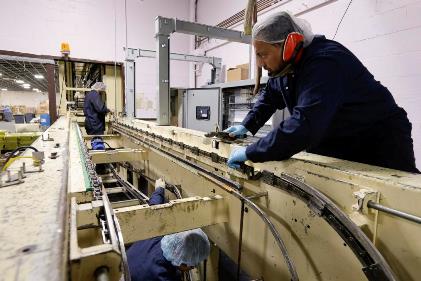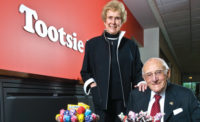
“It took 65 years to build it, four hours to destroy it and two years to rebuild. I’d say we’re not doing too badly,” says Jorge Farber, president and ceo, Madelaine Chocolates.
Not many things scare Jorge Farber (pictured) these days. After all, as he points out, “We have been to hell and back.” The president and ceo of Madelaine Chocolate can speak from experience, having seen not only what Hurricane Sandy did to his company (and to his home), but to the entire Rockaway Beach community in Queens, N.Y., where the company is based.
It’s been a slow, at times torturous, road to recovery since Hurricane Sandy hit the East Coast with a vengeance on Oct. 29, 2012.
Fortunately, thanks to a change in New York City’s administration, the company now stands to see $9.7 million channeled toward “unmet needs,” which includes replacing moulding and packaging equipment damaged during the storm. An additional $3.5 million will come from tax benefits and incentives that Madelaine Chocolate will realize during the next 13years
“We calculate that we had $30 million damage to our equipment and a $10 million loss in inventory,” Farber says. Those losses, however, didn’t come to play with the initial disbursement of Hurricane Sandy funds.
“Under Mayor Bloomberg, the money was being spread around to businesses that experienced losses,” the Madelaine ceo explains. “However, a vast majority of the businesses were either retail stores or small businesses. So they were only offering grants of $100,000, which if you qualified, allowed you to borrow another million. Unfortunately, those administrating the fund at the time didn’t understand the issue of proportionality. We were the largest employer in the region, with 400-plus workers.”
Albeit ongoing efforts, the release of additional funds was not forthcoming. But despite such financial constraints, the company was able to rebuild its business and began supplying customers with seasonal products within eight months.
Nevertheless, it became clear to Farber and the company’s management team that without any additional help, Madelaine Chocolate couldn’t progress further. Moreover, all claims to the insurance company had been denied, he adds, although the company continues to rigorously pursue appeals to the effect.
As a result, the company decided it would have to move and listed its property, which extends three city blocks, for sale.
“We were looking to relocate outside of New York City, be it somewhere in the state or elsewhere,” Farber says.” We were looking to monetize some of the properties. And there were plenty of locations that were offering huge incentives.”
Naturally, the For Sale listing quickly caught the attention of state, and city officials, as well as the media. It certainly captured newly elected Mayor de Blasio’s attention, who had campaigned on retaining, as well as creating, jobs in the city.
“Once it was understood that manufacturing can be one of the pathways to job creation, it was simple to change the equation regarding the distribution of funds,” Farber says. “So we all sat down and started generating numbers that would allow us to create those jobs.”

The $9.7-million grant will enable Madelaine Chocolate to inject momentum into the company’s production operation, thereby enabling the company to replace or repair several of the specialized pieces of equipment used in chocolate production.
Of course, the disbursement doesn’t come without conditions, he points out. “We agreed to stay in New York City for 10 years as well as significantly increase the workforce within two years.”
As it stands, the company will not see any actual cash; rather, the monies will be disbursed directly to the equipment suppliers. In addition, Farber and his team had to decide what made the most sense on various pieces of equipment, whether it was best to repair or simply purchase new outright.
“We looked at product selection as well as what would yield the most dollars, taking into account, customer service, demand and expectations. It’s all about the most bang for the buck.”
But there were other considerations as well, he notes.
“It’s not just about rebuilding or buying machines, but it’s about regaining our customer base, regaining our market share that we had before,” Farber says. “When Sandy hit, we were unable to get our products to our customers; they couldn’t replace those items that late in the game, so they also suffered significant losses.
“We did, however, promise that we would be back next season and that we would be able to supply them with most of their needs. It was with great difficulty that we were able to do so, but that solidified the idea that we really were back and provided us with additional credibility.”
He stresses that this was only possible through the “help of our friends”, a dedicated and capable work staff, and the “amazing support” the company received from the confectionery industry.
“We had great support from our lender as well as our suppliers, who granted us the terms to continue,” Farber says. “The vendors also had a sense of confidence that we would keep our word, stick do the plan and keep our promise that everyone would get paid.
“Our managers stayed loyally with us, motivated purely by their confidence that the company has too much history and can regain its pre-storm strength and standing,” he adds. Our maintenance team found the resources and abilities to repair equipment that had been rendered junk, one at a time, so that we were able to start producing chocolates within eight months after complete destruction”
That kind of support encouraged him and everyone at the company to work even harder to ensure Madelaine Chocolate’s comeback. The most recent good news coming from New York City regarding funding provides even more incentive.
And as he points out, “We love going to work every day. It’s regenerated our enthusiasm about making a great product again.”
The disaster also enabled Farber and his team to reflect on what Madelaine Chocolate is and where it’s future lies.
“It took about four to five weeks after Hurricane Sandy hit to restore electricity; the place was a disaster,” he says. “Nothing could be done before cleanup, which give us a sort of timeout. It was a time to reflect. Are we going or are we staying?”
Clearly, Madelaine Chocolate is staying. With annual sales at about half where the company was before the storm, there’s still a ways to go before the company can return to its pre-Sandy days.
“We’re just thankful to our loyal customers and suppliers,” Farber says. As for the future, Farber believes there are more opportunities for the company in branded products. And marketing will play a larger role, he asserts. “We’ll give Estee [Jorge’s daughter and the company’s marketing manager] a bit more latitude.”
So, given the aftermath of Hurricane Sandy, did or does Farber have any nightmares as a result?
A grin came to the ceo’s face in answering the question. “I didn’t sleep enough to have nightmares,” he says. Today, Farber simply dreams of a better future.





